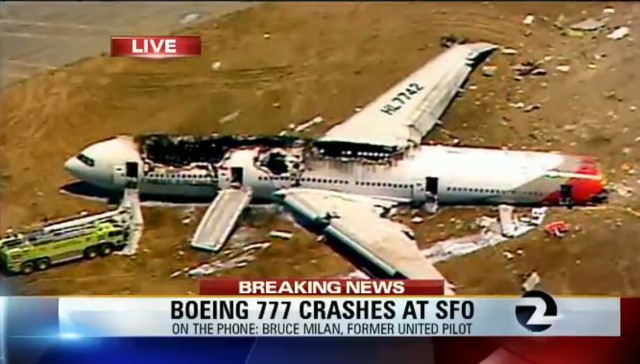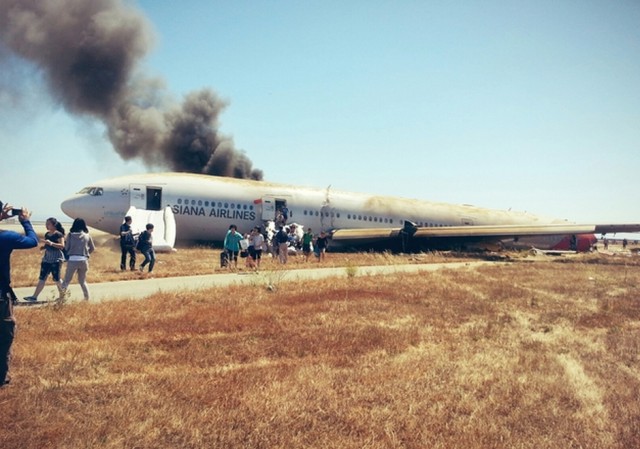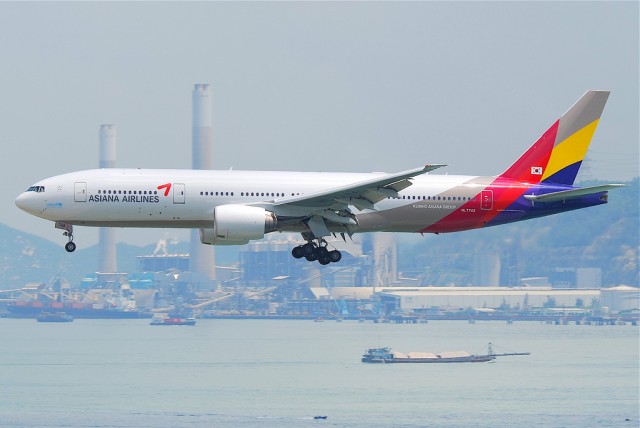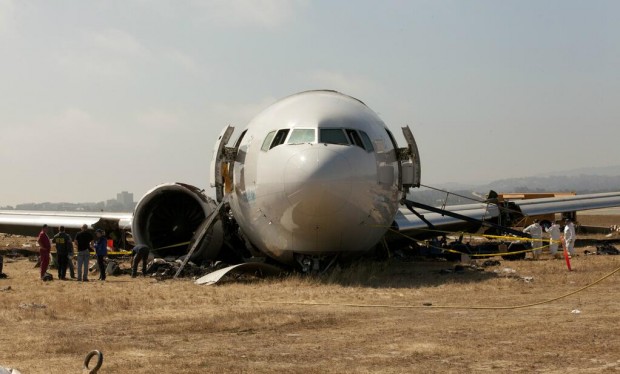
Air shot of the Asiana Airlines Flight 214 crash at SFO via KTVU.
As of 07/06 5:47pm PST, updates will be added to the bottom of the story and the main story will not change.
Just before 11:30am today, an Asiana Airlines Boeing 777-200ER (registration HL7742) coming from Incheon, South Korea, landed before the runway at San Francisco International Airport (SFO) causing the aircraft to break up. Passengers were evacuated before the aircraft caught fire. There were 291 passengers (19 business and 272 economy) and 16 crew on the aircraft. According to Asiana Airlines, the passengers, “were comprised of 77 Korean citizens, 141 Chinese citizens, 61 US citizens, 1 Japanese citizen.”
Photos show debris before runway 28, showing that the aircraft hit the ground before making it over the runway. At about 1:15pm, local San Francisco TV station, KTVU stated that two passengers died and at about 4:15pm, the SF Fire Department confirmed those deaths.
San Francisco General Hospital spoke at about 3:15pm PST and stated that they have received 10 patients in critical condition. As of 5:45pm five of those passengers improved their condition. Out of 307 passengers on board, 181 were taken to multiple hospitals. According to the SF Fire Department, there were a total of 230 passengers who has some sort of injury after the crash. Originally there were 60 passengers who were reported missing, but as of 5:45pm there is only one.
Typically with situations like this, death/injury numbers will often change.

After evacuating the crash, David Eun took this photo photo of Asiana Flight 214.
SFO was closed until about 3:30pm, when two runways were re-opened. Flights that were bound for SFO were diverted to other airports, including five that diverted to Seattle Tacoma International Airport (SEA).
The National Transportation Safety Board (NTSB) has been dispatched to identify the cause of flight 214 crashing. Boeing has also announced, via Twitter, “Our thoughts are with everyone affected by today’s incident at SFO. We stand ready to assist the NTSB.”

Asiana Airlines Boeing 777-200ER (HL7742) involved in the accident at SFO.
As we all grieve for those who have died and who are injured from this crash, we all have to remember that flying is still a very safe way to travel (see how safe it is to fly by the numbers). The positive part of an incident like this is that we will be able to learn so much so that other accidents do not happen again.
With almost 1,100 Boeing 777s delivered, this is only the second major incident the aircraft type has seen. The only other incident that has occurred with a British Airways Boeing 777 in January 2008. Flight 38 was landing at London Heathrow Airport (LHR) landed just short of the runway, which is similar to today’s accident.
UPDATE 07/07/13 2:13pm PST:
The NTSB just held a press conference and gave some additional details:
- United Airlines is stepping up to help accommodate Asiana passengers.
- The CVR and FDR (aka “black boxes”) contain “good data.”
- During the approach for landing, the engines were idle and the speed of the 777 was below the target airspeed of 137 kts.
- Seven seconds before impact, there was a call to increase speed.
- Only 1.5 seconds before impact, the crew called for a go around.
- The flight crew will be interviewed over the next few days.
- The Boeing 777-200ER involved (HL7742) was delivered to Asiana Airlines in March 2006 and had about 5000 cycles.
- They are not giving details about the two deceased passengers.
- They do not expect to come to a conclusion in the next few days and need to continue their investigation.
UDATE 07/07/13 3:50pm PST:
The NTSB has release photos of the crash scene.
UPDATE 07/08/13:
We have posted eight additional Asiana crash photos.
Posted an opinion story: A Few Thoughts on Asiana Airlines Flight 214 Crash at SFO
The NTSB has given out some additional information in a press conference earlier today:
- They are still determining if an emergency vehicle was involved in the death of one of the passengers. The coroner has still not determined the cause of death.
- Although the target landing speed is 137kts at SFO, the Asiana Airlines Boeing 777 was only going 106kts at the time of landing.
- At 1600′, the autopilot was disengaged. At 1400′, the airspeed was 170kts, at 1000′, it was 149kts and at 500′, it was only 134k.
- At about 3 seconds before impact, the aircraft was only going 103kts (the slowest before impact) and the engines were at 50% power and increasing.
- The NTSB will be reviewing all 300 seats and comparing injuries of passengers to get a better idea of what happened.
- The NTSB stated they will have another update tomorrow.
UPDATE 07/09/13:
Additional information from the NTSB today:
- The first started came from Engines #2 via an oil tank.
- Auto throttle was armed.
- All three fire handles were pulled at the time of the crash.
- Flaps were set to 30.
- The NTSB has removed all of the exterior doors and slides to be investicated.
- There were three pilots in the flight deck at the time of the accident.
- The flying pilot [left seat] has 9700 flights hours and about 5000 hours of pilot in command.He was training on the 777 and had completed 10 legs and 35 hours on the 777.
- The training pilot [right seat] has 13,000 total flight hours and 3000 in the 777. He has about 10,000 hours of command time. This was his first trip as an instructor pilot.
- This was the first time that the two pilots had flown together.
- The third pilot in the flight desk was treated for a crack rib and the other two pilots were admitted to a local hospital.
- None of the crew were tested for drugs and alcohol, since it is not a US airline.
- Two flight attendants were thrown out from the aircraft after the impact — both survived.
- The NTSB is planning another press conference tomorrow afternoon.
UPDATE 07/10/13:
More information from the NTSB during a press conference:
- After the aircraft stopped, the pilots did not tell the flight attendants to evacuate the plane.
- Once fire was reported by an flight attendant, the order was given to evacuate the 777.
- It was 1.5min after the aircraft stopped that the first door was open and emergency slides opened.
- It was about 2min after the accident until the first emergency vehicle arrived.
- With-in three minutes the first “extinguishing” vehicle started to spray the aircraft.
- The NTSB expects to “release” the runway back to the airport by tonight, with-in 24hrs at the latest.
- Flying pilot stated he saw bright flash of flight at 500′ — the NTSB is investigating.
- Pilots were interviewed for four hours each and were “very cooperative.”
UPDATE 7/13/13:For additional updates, check in with Airchive.com, thanks!
PHOTOS AND VIDEO OF ASIANA FLIGHT 214 VIA SOCIAL MEDIA (newest additions on the bottom):
- Video of smoke from SFO terminal via @360KID
- From inside the SFO terminal via @danblar
- Screen shot of wrecked aircraft from KTVU and @Manuel_arnauer
- Another aerial angle of the 777 from KTVU
- Closer shot of the burned out fuselage from KTVU and @NewsBreaker
- Raw video of Flight 214 from the air via KTVU
- Aerial photo showing debris on the ground before the runway via KOMO
- Air Traffic Control recording of Flight 214 during landing via Wandering Armean
- Crash photos from CNN
- Crash photos from the AP
- Photo from @EuniceBirdRah’s father who was on the flight
- Another photo from @EuninceBirdRah showing the 777 on fire
- Distant video of the crash via CNN
 |
This story written by… David Parker Brown, Editor & Founder.
David started AirlineReporter.com in the summer of 2008, but has had a passion for aviation since he was a kid. Born and raised in the Seattle area (where he is currently based) has surely had an influence and he couldn’t imagine living anywhere else in the world. |

It’s HL7742, a 777-200ER built in 2006. From live news feeds on UK ITV it appears to have landed heavily, touching down about 300yds short of the runway, almost in SFO Bay. The tail planes and vertical stabiliser separated from the fuselage and can clearly be seen lying just short of the runway in a trail of wreckage. The area around the No:2 engine caught fire. However all pax & crew evacuated before the fire spread to the centre fuselage
It was hl7747 NOT hl7742
Sorry Jim, but it is HL7742 — you can clearly see the registration number on the wing from the video/photos.
David
The incident at Heathrow (BA38) was 2008, not 1995.
Thanks Davey — I have updated, not sure how I got 1995. That is the year the first 777 was delivered.
David
“The only other incident that has occurred with a British Airways Boeing 777 in May 1995.” I think flight 38 was January 2008.
That is correct — I have updated.
Thanks, David
I get a kick out of the folks who took the time to grab major pieces of luggage, particularly in this shot:
https://twitter.com/BenLevy74/status/353673607362277376/photo/1
I hope they didn’t prevent others from getting out safely.
Crazy story that was breaking while I was departing SNA this afternoon. Listening to the ATC broadcast the crew of the Asiana plane is speaking some heavily accented english. I can’t understand what the guy was saying.
I too was stunned by the photo of people going down the chutes with their luggage.
It seems as though HL7742 was built in February of 2006. The earliest photo that I am able to find is a test flight (KPAE) on March 1, 2006.
The San Francisco Airport had intentionally disabled ground-based landing guidance system at the time of the crash. The pilot did not make a distress call before landing. The Boeing 777 crashed in favorable weather partly cloudy skies and light wind.The twin-engine Boeing 777-200 is one of the most popular and safest long-range planes, often used for flights of 12 hours or more, from one continent to another.
The Asiana Flight 214 was arriving on Runway 28 which originated from Shanghai, China, left Seoul”s Incheon International Airport 10 hours and 23 minutes before its crash landing. The 7 years old old, Pratt & Whitney PW4090-powered aircraft entered final approach at an abnormally low speed of 98 knots per hour (181 km/h) – well below the target landing speed of 137 knots per hour (253 km/h).
The pilot came in short of the runway, tried to correct buy pulling up, got the nose too high and hit tail first. The plane crashed hard to the ground, smashed the landing gear and spun around. The fuel tanks ruptured, but being at the end of the flight did not contain a lot of fuel and the resulting fire was ”relatively” small and nearly everyone was able to get out in good shape.
The aircraft, registered as HL7742, was delivered on March 07, 2006, and had accumulated 35,700 hrs on 5,185 cycles as of March 31, 2013.
The two teenage Chinese women 16 yrs & 17 yrs old – may have been run over and killed by a rescue vehicle. One child and five adults remained in critical condition.
A total of 307 people were on board, 291 passengers and 16 crew members. The passengers included 77 Koreans, 141Chinese, 61 Americans, 3 Indians, 1 Japanese, 1 Vietnamese, and 7 of unknown origin.
The plane approached the runway too low and something may have caught the runway lip may be the the sea wall installed at the end of the runway to prevent planes that overrun a runway from ending up in the water.
Asiana has recently tried to expand its presence in the US and joined the Star Alliance, which is anchored by United Airlines in the US.
98 kts sounds way too slow, because i *think* it’s below the flaps-down stall speed of the 777. the 137 kts target speed is supposed to be vstall + 30%, so the math puts vstall at 105 kts. there’s no indication that the plane stalled on final approach, at least not before the end of the runway.
OZ 214 originates in Seoul KR, NOT Shanghai, CN.
All carriers in Asia use Hub and spoke, feeders/ distributors. China Air can not originate a flight from the Philippines, Asiana can not originate a flight from China.
JerryF:Asiana 214 did originate in Shanghai, then made a stop in Seoul, then flew onto SF.
That’s some crash.
Very terrific publish. I just now became aware of your blog as well as want to mention that I’ve got genuinely treasured searching your blog articles. Naturally I am following on your own feed using this program . wanting you write again immediately!
dear sir I have a few questions for you. If The San Francisco Airport had intentionally disabled their ground-based landing guidance system. And the plane was using his autopilot would the plane be off on final approach. Because there is a conflict between the captain and autopilot. In that the captain stated he seen the Autopilot misguiding the plane and turned it off and started a redirect. The other thing is, if the ground-based landing guidance system was off than why was the plane on autopilot on approach. Last and final question. As some airports have realigned their runways because of the shifting in the magnetic poles, such as the one at Peter O. Knight airport in Florida redesignating its 3,000 meter runway 23/05 as 22/04 was 180 degrees and now is 190 degrees. because of the complications of lining up planes on final approach. mapping of your flight is known after you set your known location as from where you start. that is a given before you depart from the FFA if I am not mistaken. It used to be a given above the gate. but because of the magnetic wondering it is now given by the FAA before you map your flight.. Your approach would than be recorded on your flight plan on the onboard computer, correct? And I know all this would have to do with wind and speed. Pilots always having to recompute or computers on board would recompute. I fly a lot as I am sure you do. But I am not a pilot like you. It seems worldwide when I look at the near misses and under and over shot airplane landings and redirects and some fails like flight 214 It makes me wonder. Until you get visual on the runway you are guided by that not so good trusted compass and the final location grid point or Azimuth. So sir in being honest can you see that something no one is talking about,, Is that everything is up to that compass to get you close and I see a modern day problem with the magnetic compass shifting some days to fast and that makes your Azimuth all wrong. though it was clear weather did the autopilot, that trusted sort of navigation have the wrong bearing on flight 214 and come up short. because in the past three years I have been in three planes that did another re-approach to get lined up. and I have seen a lot of missed landings that don’t make the news. because they came up short or long with no great danger to plane or people. unless you were in Japan where they had two in the last year. and the one in Myanmar where the weather was bad and the pilots ditched in the river for it was to late for a redirect. or the one in Bali Indonesia that also came up short and ditched in the ocean along the shore. If a plane has it’s nose up as it descends with the pilot having no visual on the landing until the plane starts to level out. or bad weather with poor visibility giving little or no warning that your plane is just a couple feet of course. your final coordinates were just a little off. I notice that when I check this with a pole shift jump it seems likely. The one in Bali the pole jumped by seven kilometers at that time. So there is my question to you sir. Could this happen because of a magnetic pole shift???? Otherwise it is just another pilot that takes the fall. and I don’t believe that for a second.